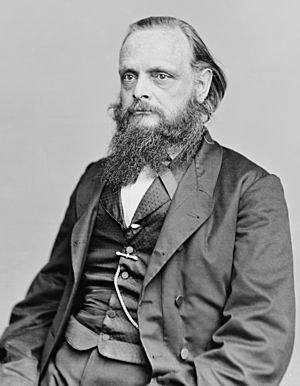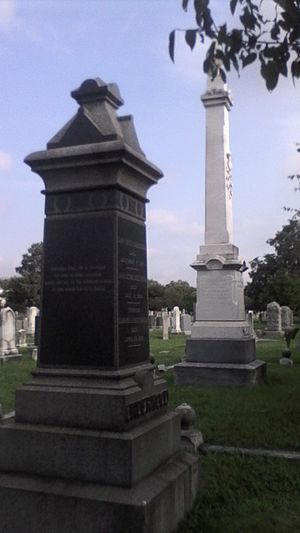John Curtiss Underwood facts for kids
Quick facts for kids
John Curtiss Underwood
|
|
|---|---|

Underwood as Judge of the United States District Court of Virginia in 1866.
|
|
| Judge of the United States District Court for the Eastern District of Virginia | |
| In office February 3, 1871 – December 7, 1873 |
|
| Appointed by | operation of law |
| Preceded by | Seat established by 16 Stat. 403 |
| Succeeded by | Robert William Hughes |
| Judge of the United States District Court for the District of Virginia | |
| In office June 11, 1864 – February 3, 1871 |
|
| Appointed by | operation of law |
| Preceded by | Seat established by 13 Stat. 124 |
| Succeeded by | Seat abolished |
| Judge of the United States District Court for the Eastern District of Virginia | |
| In office March 27, 1863 – June 11, 1864 |
|
| Appointed by | Abraham Lincoln |
| Preceded by | James Dandridge Halyburton |
| Succeeded by | Seat abolished |
| Personal details | |
| Born |
John Curtiss Underwood
March 14, 1809 Litchfield, New York, US |
| Died | December 7, 1873 (aged 64) Washington, D.C., US |
| Resting place | Congressional Cemetery Washington, D.C. |
| Political party | Whig Liberty Free Soil Republican (from 1854) |
| Education | Hamilton College read law |
John Curtiss Underwood (March 14, 1809 – December 7, 1873) was an American attorney and a strong supporter of ending slavery. He also served as a United States federal judge in Virginia. He played a big role in shaping Virginia's government after the American Civil War.
Contents
Early Life and Education
John Curtiss Underwood was born in Litchfield, New York, in 1809. He went to Hamilton College and graduated in 1832. After college, he moved to what was then western Virginia. He taught children in Clarksburg, West Virginia for two years.
Later, he went back to New York to study law. This meant he learned law by working with experienced lawyers. He then started his own legal practice. He worked as a lawyer in both New York and Virginia from 1839 to 1856.
Family Life and Moving to Virginia
In 1839, John Underwood married Maria Gloria Jackson in Fauquier County, Virginia. Maria was one of his former students. Her cousin was Stonewall Jackson, a famous Confederate general.
The Underwoods lived in Herkimer County, New York, for about ten years. They had two daughters and a son, Edward. Later, they moved to Clarke County, Virginia, to be closer to Maria's family.
Political Views and Fighting Slavery
John Underwood first belonged to the Whig Party. But as that party broke apart, he joined the Liberty Party in the 1840s. He joined this party because he was against slavery.
He ran for political offices like U.S. Representative but did not win. In 1848, he joined the Free Soil Party. The next year, he moved his family back to Virginia. He hoped to show that using free workers on his dairy farm was better than using enslaved labor.
Becoming a Republican and Facing Threats
When the Republican Party started, Underwood was one of its first supporters in Virginia. In 1856, he went to the party's meeting in Philadelphia. There, John C. Frémont was chosen to run for president.
Underwood strongly supported Fremont and the idea of ending slavery. Because of his strong views, he received threats. In 1857, he left Virginia for a short time and wrote about his experiences in The New York Times.
He also worked to encourage people who supported the Republican Party to move to the Ohio River counties of Virginia. These counties later became West Virginia. His efforts stopped after John Brown's raid on Harpers Ferry in 1859. During this time, Virginia officials took over the Underwoods' property.
Underwood also helped fund the Wheeling Daily Intelligencer newspaper. This paper became a very important Republican newspaper in a slaveholding state. In 1860, he was a delegate at the Republican Convention that chose Abraham Lincoln as its candidate. He campaigned for Lincoln and gave a speech in Virginia supporting him.
Working for the Government
In 1861, John Underwood was offered a job as a United States Consul in Callao, Peru. But he turned it down. Instead, he took a job in the United States Department of the Treasury. He worked there from 1861 to 1864. For the rest of his life, he lived in Alexandria, Virginia, and Washington, D.C..
Serving as a Federal Judge
President Abraham Lincoln appointed John Underwood as a judge for the United States District Court for the Eastern District of Virginia in 1863. He was confirmed by the United States Senate in 1864. He continued to serve as a federal judge until he passed away in 1873.
Important Cases as a Judge
As a judge, Underwood handled some very important cases after the Civil War. In 1866, he oversaw the grand jury that charged Confederate president Jefferson Davis with treason. He later allowed Davis to be released on bail.
He also oversaw a grand jury that charged Confederate General Robert E. Lee. However, General Ulysses S. Grant and other government officials did not pursue the case. They felt it went against the surrender terms.
Underwood strongly believed the government had the right to take property from those who supported the Confederacy. His court took more Confederate property than any other in the country. He wanted to break the power of the slaveholding class. However, the U.S. Supreme Court later disagreed with some of his interpretations of the law.
In 1865, Underwood was chosen to be a U.S. Senator by a Virginia legislature. But he was not allowed to take his seat. Many senators did not want to let Confederate states rejoin the Union too quickly. He continued his work as a federal judge.
Underwood kept speaking out against former Confederates. He strongly supported the right for African Americans to vote. In 1865, he wrote a letter supporting full citizenship and voting rights for African Americans. He also criticized laws that stopped African Americans from speaking in court.
In 1867, Judge Underwood was involved in preparing for the trial of Jefferson Davis again. He helped choose a jury that included both African-American and Anglo-American men. However, the case against Davis was eventually dismissed.
The Underwood Constitution
Underwood was also a delegate at the Virginia Constitutional Convention of 1868. This was the first time African-American delegates were part of a Virginia legislative body. He was chosen as the president of this convention.
At the convention, Judge Underwood was very influential. He and the convention proposed giving the right to vote to all men over 21, including black citizens. He also wanted schools to be open to everyone, regardless of race.
Many white Virginians did not like the idea of black citizens voting. They formed the Conservative Party of Virginia to oppose the new constitution.
However, the convention finished its work. The new constitution was the first in Virginia to grant voting rights to all men over 21. It also created public education for everyone and changed how county governments worked.
A controversial part of the constitution was about restricting voting rights for Confederate veterans. After negotiations, this part was removed. The voters then approved the constitution in 1869. This allowed Virginia to rejoin the Union and send representatives to the federal government. This constitution is often called the "Underwood Constitution."
Underwood was also one of the few people at the convention who supported women's right to vote. He and his wife, Maria, helped organize the Virginia State Woman Suffrage Association in 1870.
Later Years and Legacy
Judge Underwood continued to support the rights of African Americans through his work as a judge. However, some of his decisions were overturned by higher courts. For example, he ruled that racial segregation on railroad cars was wrong.
John Curtiss Underwood passed away in 1873 in Washington, D.C. He is buried in the Congressional Cemetery there. Many Virginia newspapers criticized him for decades after his death. However, others, like author Harriet Beecher Stowe, wrote positive tributes about him.
The constitution that Underwood helped create was changed several times over the years. Some of his papers are now kept at the Library of Congress and the Library of Virginia.
Images for kids



